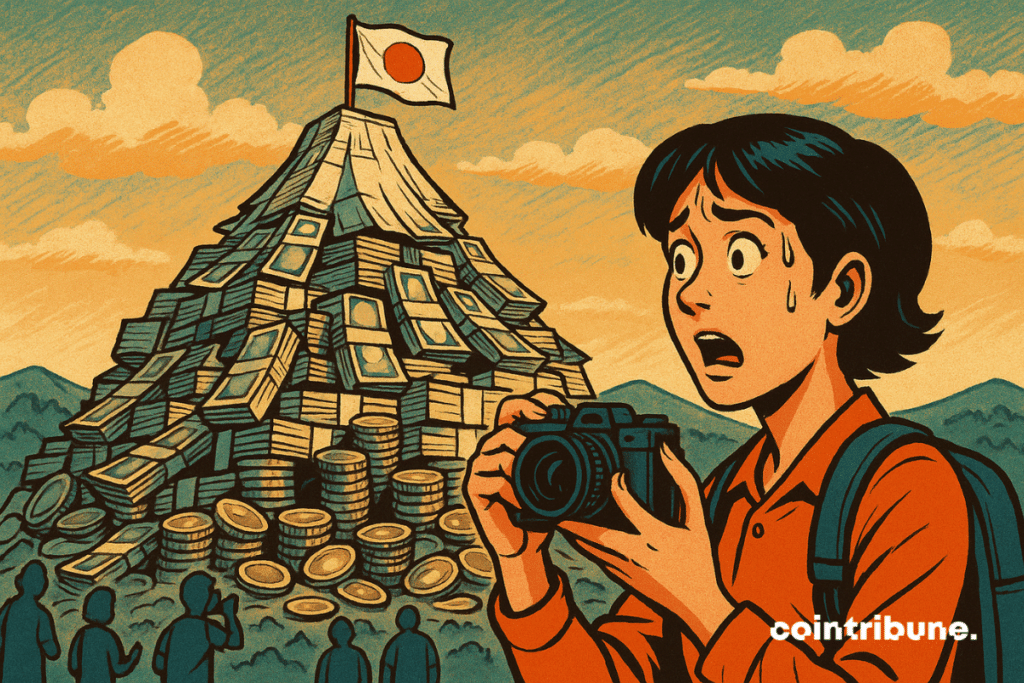12h05 ▪
6
min read ▪ by
How long will Japan be able to withstand the surge in borrowing rates without resorting to printing money?


In brief
- Japanese borrowing rates have soared since the end of Quantitative Easing. The debt/GDP ratio has reached 260%, higher than that of Greece.
- The root causes of this debt: an aging population (40% over 65 by 2035) and rising healthcare and pension costs.
- Bitcoin is the obvious store of value in the face of the collapse of fiat currency values.
What is happening in Japan?
In 45 days, the Japanese government’s 30-year borrowing rate soared by 1%, reaching a record high of 3.20%. While the 40-year rate was only 0.25% in 2018, today it stands at 3.5%, amid trade tensions with the United States.
Rates have been rising relentlessly since the Bank of Japan (BoJ) stopped buying public debt through “Quantitative Easing.”
Consider that it already holds 52% of the entire public debt! This means the Japanese government no longer pays interest on 52% of its debt. Japan would probably have defaulted already without the BoJ.
Japanese debt amounts to 7,800 billion dollars. This grand total makes the Japanese government the third most indebted government in the world, behind the United States and China.
The debt-to-GDP ratio recently exceeded 260% for the first time in its history. This is twice as much as the United States. Japan has one of the worst ratios in the world alongside Greece, Lebanon, Sudan, Argentina, and Venezuela.
Last week, the Japanese Prime Minister declared that the country’s financial situation was “worse than that of Greece”… However, it should be noted that the country’s foreign exchange reserves reach 1,400 billion dollars and the public pension fund is well stocked with 1,600 billion.
By comparison, France holds only 530 billion in reserves and has no pension fund (pay-as-you-go retirement system). Perhaps it’s time to accumulate bitcoins mined by EDF…
Why does Japan have such debt?
The high level of public debt mainly results from decades of persistent budget deficits and near-zero economic growth, both largely attributable to the aging population.
The cause is Japan’s low fertility rate. In 2001, the share of the Japanese population over 65 was 18%. It was 30% in 2024 and will be nearly 40% in ten years.
The increase in life expectancy combined with demographic decline has burdened public accounts due to pensions and healthcare expenses. The major reforms starting in 2010 to reduce medical expenses and pension weight have not been sufficient. It is hard to see how rates could fall in such a context.
The only escape would be to print money again. Rates would fall, but this would ultimately be paid for by higher inflation and a weaker yen. Inflation is nearly 4% and the yen has been free-falling since 2011 (-46%). There are no miracles…
The trend is similar in the United States. Debt reaches 130% of GDP, about half of what Japan experiences. However, unlike Japan, the United States shows a gargantuan trade deficit of over 1,100 billion dollars per year.
The currency of any country with such a deficit should collapse and cause massive inflation. This is not the case in the United States, which has the advantage of issuing the international reserve currency. But for how much longer?
The BRICS no longer want the dollar and even the CEO of BlackRock sees bitcoin taking over if the U.S. government does not reduce its deficits.
Bitcoin vs fiat Ponzi scheme
Despite campaign promises, the U.S. deficit is expected to increase by 3,800 billion dollars this year. The new Treasury Secretary Scott Bessent has ultimately chosen to bet on GDP growth rather than cutting spending.
Unconvinced, Moody’s downgraded the U.S. rating on May 17. Indeed, energy is required to generate growth.
Growth = Production = Machines = Energy = Oil (95% of transport runs on oil)
The United States was able to get out of the 2008 crisis (peak of global conventional oil) thanks to shale oil. Unfortunately, these last reserves are already depleted:
In other words, just like in Japan, inflation is inevitable. It has actually been 25% over the last five years. That’s how it is, oil, copper, lithium, cobalt, or nickel are not printed.
The backlash will be tough and Washington knows it. One way out would be to accumulate millions of bitcoins before everyone else. On that note, watch closely the statements of Vice President JD Vance this Wednesday, May 28 during the Bitcoin Conference.
Let’s finish by recalling that inflation hits small budgets hard, while those who own luxury real estate, artworks, etc., benefit.
Sure, there is no oil in the blockchain, but bitcoin is the best store of value in human history accessible to all. You can buy 100 euros worth of bitcoins, but not 100 euros worth of the Mona Lisa.
Don’t miss our article: Bitcoin is a much better investment today than ten years ago.
Maximize your Cointribune experience with our “Read to Earn” program! For every article you read, earn points and access exclusive rewards. Sign up now and start earning benefits.
Bitcoin, geopolitical, economic and energy journalist.
DISCLAIMER
The views, thoughts, and opinions expressed in this article belong solely to the author, and should not be taken as investment advice. Do your own research before taking any investment decisions.

Leave a Reply